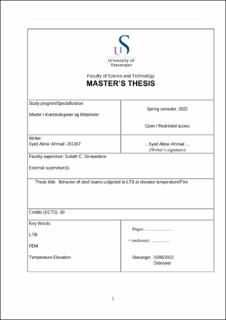| dc.description.abstract | When the steel beam is subjected to fire, there are great chances for the steel beam to decrease
its stiffness due to which the flexural and lateral torsional buckling capacity (LTB) properties
of respective steel beam affected. At an elevated temperature, there exist a non-linear stressstrain behavior of steel beam at an elevated temperature. The steel beam is subjected to fire
under different elevated temperatures in Finite Element Modeling tools and ANSYS to
investigate the behavior and changing properties during the elevated temperature. The FEM is
considered validated instead of experimentation for fire in laboratory because to get such high
temperature just for prototype or modeling is not achievable, thus, to study the behavior of steel
using modeling techniques. The specific modeling tools create an experimental model to study
by carrying the set of parametric studies. The steel beam is analyzed by changing the thermal
properties, mechanical and physical properties at an elevated temperature.
The main theme of this research congested only with lateral torsional buckling moment
capacity of I-beam and non-dimensional slenderness ratio. Buckling plays an important in the
stability of structures.
To investigate this, there are five cases while analyzing the I-Beam throughout the crosssection and at various locations when subjected to fire or elevated temperature.
1) Case 01: No fire or elevated temperature: In this case, the steel beam is analyzed
without having elevated temperature.
2) Case 02: Whole cross-section of the beam is subjected to fire or elevated temperature
of same nature. The reduction in physical properties are applied throughout the beam.
3) Case 03: The elevated temperature in the beam is subjected to whole bottom flange and
half of web in uniform way.
4) Case 04: In this case, the elevated temperature is subjected to top and bottom flange
and web at L/3.
5) Case 05: In this case, the elevated temperature is subjected to 1/3 of mid-span length
of the I-beam at the bottom flange and the lower half of the web.
The purpose and objective of this study to analyze how the steel beam behave in case of
subjected to fire, in different scenarios discussed above, on lateral torsional buckling capacity
(Mb,Rd). When different test is applied through FEM, then it came to know that the steel
specimen is getting failed under LTB irrespective of fire and end support condition. There exist
two kinds of buckling while studying; one is linear buckling analysis and nonlinear buckling
analysis. It is common observation that, with the increase in temperature, the length of the steel
beam also increases due to the phenomenon of expansion or contraction properties of steel in
an increasing or decreasing way of external temperature. By increase in the length of the steel
beam, the lateral buckling capacity and flexural strength decrease that may result in the collapse
of structure, thus this study is carried out to analyze this behavior to improve and suggest the
modifications while designing the structures based on fire loading. After doing the analysis,
the results are explained in a detailed way.
At an elevated temperature, there is reduction in strength of steel and stiffness of material with
which beam is made, i.e., stainless steel. As stainless steel is alloy of different material, so it
provides better retention as compared to carbon steel.
Stainless steel beams are capable of bearing more temperature because they have high value of
coefficient of thermal expansion as compared to carbon steel | |
